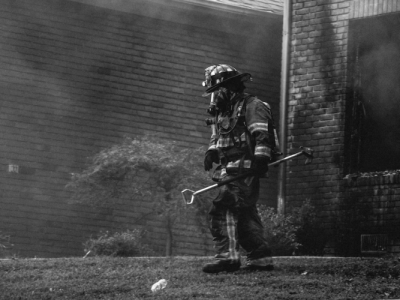The vital role of firefighting in safeguarding military personnel and installations has led to the widespread use of AFFF at military bases. AFFF, a firefighting foam renowned for its effectiveness in extinguishing flammable liquid fires, has become an integral component of emergency response.
However, the seemingly indispensable properties of AFFF come at a cost. One that has ignited growing concerns about water quality at military bases around the world.
In this article, we delve into the intricate relationship between AFFF chemicals and water quality at military bases.
What are AFFF Chemicals?
Aqueous Film-Forming Foam (AFFF) is a specialized firefighting foam employed by the military to combat flammable liquid fires effectively. It operates by forming a thin, cohesive film on the surface of the fire, smothering and suppressing it. AFFF is particularly crucial in emergencies, given its capacity to rapidly contain and extinguish dangerous blazes involving fuel-based fires.
However, the composition of AFFF raises significant concerns. AFFF contains per- and polyfluoroalkyl substances (PFAS). PFAS are a class of synthetic chemicals that exhibit exceptional resistance to degradation.
Regrettably, the persistence of PFAS in the environment has led to alarming contamination of water sources. These chemicals have a proven tendency to accumulate in aquatic ecosystems and even infiltrate drinking water supplies.
Furthermore, many municipal water filtration systems aren’t equipped to eliminate PFAS from water and necessitate specialized filtration methods.
How Do AFFF Chemicals Impact Water Quality?
AFFF contamination is particularly concerning at military bases because of their extensive use at these sites. When AFFF is employed in firefighting scenarios or training exercises, it can infiltrate water sources through multiple pathways. It can runoff from firefighting sites, accidental spills, and improper disposal practices.
Research has linked PFAS exposure to an array of health issues, ranging from cancer and liver damage to compromised fertility and developmental problems. Consequently, the impact of AFFF chemicals on water quality extends beyond mere environmental considerations, emphasizing the urgency to address this issue.
The Extent of the Problem
AFFF chemicals have been found in the water supplies of communities near military bases across the United States.
According to the ACS Publications, contamination of drinking water with PFAS is extensive in the vicinity of over 300 U.S. military bases. These sites used AFFF for firefighting and fire training purposes.
A significant portion of the PFAS found at these locations comprises precursor compounds capable of converting into problematic end products. The assessed reservoir of PFAS in the vadose zone indicates that PFAS pollution exceeds regulatory standards. It was further noted that the chemical will endure for centuries unless corrective measures are undertaken.
The extent of the problem of AFFF contamination is a serious concern for public health. People who live near military bases should be aware of the potential health risks of PFAS exposure and take steps to protect themselves.
What Is Being Done to Address the Problem?
The Guardian reports that recently, chemical giant 3M reached an agreement to pay $12.5 billion to resolve a lawsuit regarding PFAS contamination within water systems. This accord was celebrated by lawyers as the “largest drinking water settlement in American history” and a significant advancement in the public’s fight against harmful “forever chemicals.” A subsequent settlement with PFAS manufacturers DuPont, Chemours, and Corteva amounted to a substantial $1.1 billion.
Although these figures seem remarkable, they merely represent a fraction of the projected $400 billion required to cleanse the country’s drinking water.
Outlined below are specific instances of actions taken to combat the issue of AFFF contamination:
- Formulating novel firefighting foams that are free from PFAS chemicals.
- Transitioning to an alternative AFFF variant with reduced PFAS chemical content.
- Engaging in the remediation of polluted sites. This encompasses eliminating PFAS chemicals from soil and groundwater and ensuring the provision of safe drinking water to impacted communities.
- Raising awareness among the public regarding the hazards associated with PFAS exposure.
Legal Response to the Problem
In response to the AFFF contamination crisis, legal avenues have emerged to address accountability and facilitate remediation. Notably, the legal landscape witnessed the emergence of the firefighter foam lawsuit. A pivotal legal action that aimed to hold manufacturers accountable for the adverse effects of AFFF chemicals.
According to TorHoerman Law, this lawsuit alleged that manufacturers were aware of the health risks posed by PFAS compounds in AFFF. Yet they failed to adequately inform the military and firefighting personnel.
Consequently, manufacturers faced allegations of negligence, resulting in groundwater contamination and health concerns. This legal action by affected communities and military personnel seeks legal redress to mitigate the ramifications of AFFF contamination.
The Challenges in Addressing the Problem
The cleanup of AFFF contamination is a complex and challenging process for several reasons:
- The chemicals are difficult to remove from the environment. They are also very mobile, meaning that they can travel long distances in groundwater. This makes them difficult to remove from the environment.
- The cost of cleanup is high. The military estimates it will cost billions to clean up all the contaminated sites.
- The cleanup process can be disruptive to communities. The cleanup of AFFF contamination can involve the excavation of soil and groundwater, the use of chemicals, and the construction of treatment facilities. This can be disruptive to communities, and it can also raise concerns about the safety of the cleanup process.
Despite the challenges, it is important to address the problem of AFFF contamination. The cleanup process will be difficult and expensive, but it is necessary to protect the public from exposure to PFAS chemicals.
Conclusion
As we navigate the complex journey of mitigating AFFF-related contamination, it is evident that the pursuit of cleaner water demands unwavering dedication. The road ahead is full of complexities, but the imperative to safeguard both the environment and public health remains paramount.
Ultimately, the strides taken today will shape a cleaner and safer tomorrow for military bases and the communities they coexist with.
















Comments